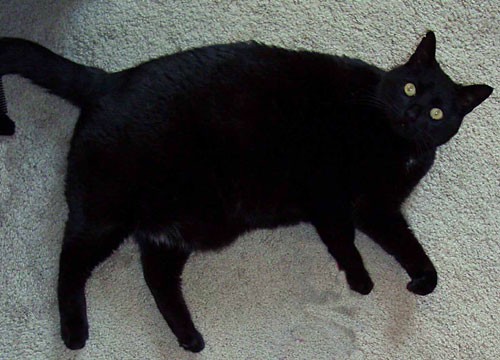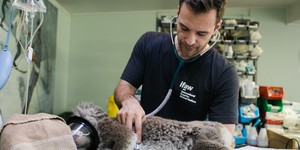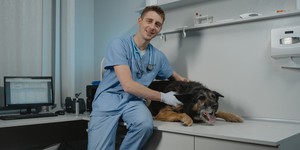Abstract
Did you know that there are over 58 million overweight cats and dogs in the United States? Is your pet one of them? How about your neighbor's cat or your grandma's dog? In this science project you'll determine what percentage of the pets you know are overweight and how their weights compare to pets' weights throughout the United States.Summary
Sandra Slutz, PhD, Science Buddies

Objective
In this science project you'll determine the percentage of overweight pets among the cats and dogs you know.
Introduction
Have you ever looked at a dog or cat and thought to yourself, "Wow, that pet is fat!"? You may be noticing that many pets you see are overweight, meaning they weigh more than they should. Animals, including humans, that are severely overweight are referred to as obese. The Association for Pet Obesity Prevention estimates that about 45 percent of the pets in the United States are overweight, or obese. That's over 58 million fat cats and dogs!
 Image Credit: Kristin Strong, Science Buddies / Science Buddies
Image Credit: Kristin Strong, Science Buddies / Science Buddies
Why does it matter if a cat or dog is overweight? Similar to humans, carrying extra fat puts cats and dogs at risk for a variety of health issues. Overweight pets are more likely to develop diabetes, heart and lung diseases, and arthritis, so it's important to keep your pets from becoming overweight by making sure they're getting plenty of exercise and the proper nutrition.
The first step to evaluating a pet's fitness is to determine if it is overweight. Veterinarians do this in a number of ways. One way is to use their hands and eyes to inspect the animal and see if it has rolls of fat along its stomach, or other places where fat shouldn't accumulate in a fit pet. Another method is to weigh the animal. Every animal has an ideal weight, which is the weight that a healthy and fit animal should be. The ideal weight is usually a range and may take into account whether an animal is male or female. Males of most breeds tend to be larger and more muscular than females, so they weigh more. Ideal weight varies depending on the breed of cat or dog. After all, you can't expect a German shepherd to be as light as a beagle!
Are the pets you know overweight? Find out by doing this science project to determine the percentage of overweight pets among the cats and dogs you know. You'll weigh each pet and compare its weight to the animal's ideal weight. Good luck experimenting and remember, if a pet is overweight it's never too late for it to get fit!
Terms and Concepts
- Overweight
- Obese
- Diabetes
- Arthritis
- Ideal weight
- Breed
Questions
- How can you tell if a dog or cat is overweight?
- Where can you find out the ideal weight for a cat or dog?
- How does weight relate to an animal's overall health?
Bibliography
These websites will give you more information on pet obesity.
- Association for Pet Obesity Prevention. (2007). Pet Obesity Facts & Risks. Retrieved May 14, 2008.
- Clemans, V. (n.d.). Obesity in Your Pet. Retrieved May 14, 2008.
- The Ohio State University College of Veterinary Medicine. (2008). Body Condition Scoring Chart. Retrieved May 14, 2008.
This website offers help with creating graphs:
- National Center for Education Statistics. (n.d.). Create a Graph. Retrieved May 14, 2008.
To print out polar graph paper for a pie chart, visit this website:
- Incompetech. (n.d.). Polar Graph Paper PDF Generator. Retrieved May 14, 2008.
Materials and Equipment
- Cats and/or dogs (minimum of 15)
- Bathroom scale
- Lab notebook
- Compass and protractor, or polar graph paper, or a computer with Internet access
Experimental Procedure
Finding Pets to Include in Your Science Project
-
To do this science project you will need to weigh a large number of cats and/or dogs. You should collect data from at least 15 animals, but more is better! It is unlikely that you have 15 cats and dogs in your home, so here are some ideas on how you can find more pets to include in your science project. Be sure to take an adult along with you for assistance with the pets.
- Explain your science project to your neighbors who have pets and ask if you can include their pets in your science project.
- Contact friends and family members who have pets and ask if you can include their cats and dogs in your science project.
- Contact a local veterinary clinic and explain your science project to them. Ask if they'd allow you to collect data from pets that come to their clinic on a specific day.
- Visit a local dog park and ask the owners if they would mind if you analyzed their pets for the science project.
-
To increase the number of animals you collect data from, it is fine to use both cats and dogs in for your science project. If it's easier for you, you can also use all cats or all dogs.
- Make sure all of the animals you collect data from are adults, meaning that they are at least 1 year old. Puppies and kittens are still growing rapidly, so it is difficult to know what their ideal weight should be and whether or not they are overweight.
Collecting Your Data
-
Once you've figured out where you are going to find all the animals for your science project, it is time to weigh them.
-
Whether you collect your data in pounds (lb) or kilograms (kg) depends on the type of scale you have. But many of the websites and books that list ideal weights for different breeds of dogs and cats use pounds. One kilogram is equal to 2.2 pounds, so if you need to convert from kilograms to pounds, use Equation 1, and if you need to convert from pounds to kilograms, use Equation 2.
Equation 1:
Pet's weight in kilograms = Pet's weight in pounds / 2.2
Equation 2:
Pet's weight in pounds = Pet's weight in kilograms x 2.2
-
Whether you collect your data in pounds (lb) or kilograms (kg) depends on the type of scale you have. But many of the websites and books that list ideal weights for different breeds of dogs and cats use pounds. One kilogram is equal to 2.2 pounds, so if you need to convert from kilograms to pounds, use Equation 1, and if you need to convert from pounds to kilograms, use Equation 2.
-
Using the bathroom scale, weigh the person who can most easily pick up the cat or dog. Record his or her weight in a chart in your lab notebook. Be sure the scale is on a hard, even surface.
- Remember, some cats and dogs don't like to be picked up. For the animal's comfort and your safety, make sure the animal is comfortable with the person who is going to pick him or her up. Adult supervision is recommended.
- If the animal is large, you'll need an adult to do the lifting.
- Have the same person pick up the pet and step back on the scale. Record the new weight.
-
Subtract the person's weight from the combined person+pet weight, see Equation 3. The resulting number is the weight of the pet:
Equation 3:
Pet's weight = (Person + Pet weight) - (Person's weight)
Type of Pet (Cat/Dog) Breed Gender (Male/Female) Person's Weight (lbs) Person+Pet Weight (lbs) Pet's Weight (lbs) Pet's Ideal Weight (lbs) Overweight (Yes/No) Dog Cat -
Once you've calculated a pet's weight, you'll need to compare that weight to the animal's ideal weight. Ideal weights are usually given as a range. Record the ideal weight range for each animal in your chart.
- Finding the animal's ideal weight will take some research. You can find a list of ideal weights for the most popular dog and cat breeds on the Association for Pet Obesity Prevention's website.
- For other dog and cat breeds' ideal weight ranges, you should consult books about different breeds. There are also websites, like the American Kennel Club, dedicated to specific breeds of dogs and cats. If you can't find the information you need, a local veterinarian would also be a good reference.
- Sometimes ideal weights are different for a male versus a female animal. Make sure you've recorded the gender of each pet in case that data becomes important in determining whether he or she is overweight.
- Look at the data you've collected for each pet. Does each pet's weight fall within the ideal weight range? If it is greater than the ideal weight range, the pet is overweight. If it is within or below the ideal weight range, then the pet is not overweight. Record your findings in your chart.
Analyzing Your Data
- Calculate what percentage of the pets you collected data from are overweight.
-
Make a pie chart showing your results.
- You can use a compass and a protractor to draw the pie chart circle and divide it into the appropriate-sized pieces, one for the percentage of pets who are overweight and the other for the percentage of pets who are not.
- Or, you can use polar graph paper to make your pie chart. Polar graph paper is already divided into wedges, so you can just count out how many wedges you need for each category. You can buy polar graph paper at an office supply store or print it out for free from Incompetech.com.
- If you prefer to make your pie chart on the computer you can use the Create a Graph website to make your chart and then print it out.
- Is the percentage of overweight pets higher or lower than you expected? How do your findings compare to the Association for Pet Obesity Prevention's estimate that approximately 45% of all pets are overweight?
Ask an Expert
Variations
- In the science project above you combined the data for cats and dogs. If you have enough of each type of animal, try separating the data. Is the percentage of overweight cats similar to the percentage of overweight dogs?
- Sometimes veterinarians take into account more than just weight when determining if an animal is overweight. They can also look at the animal's general body shape and where the fat is located. Try doing this project using the Body Condition Scoring Chart from The Ohio State University's College of Veterinary Medicine, instead of weight.
- Do overweight pets have more health problems? Survey your pet owners and find out.
- Are older pets more likely to be overweight than younger pets? Design an experiment to find out.
Careers
If you like this project, you might enjoy exploring these related careers:









